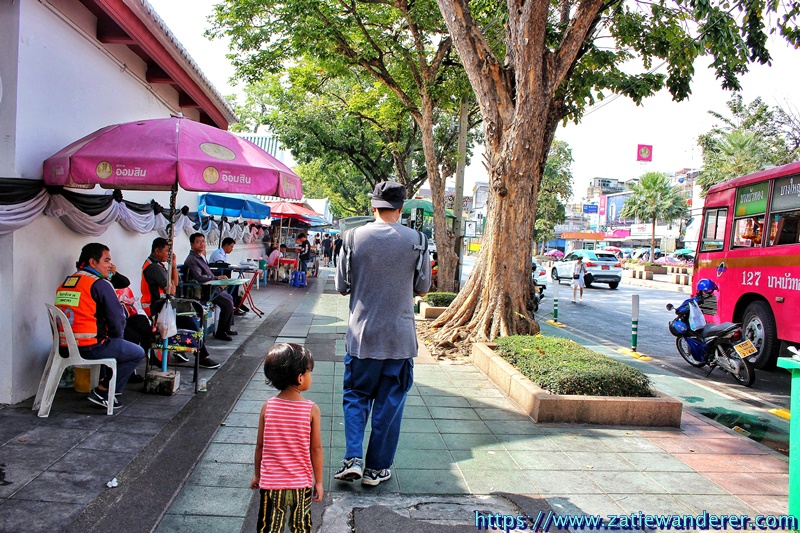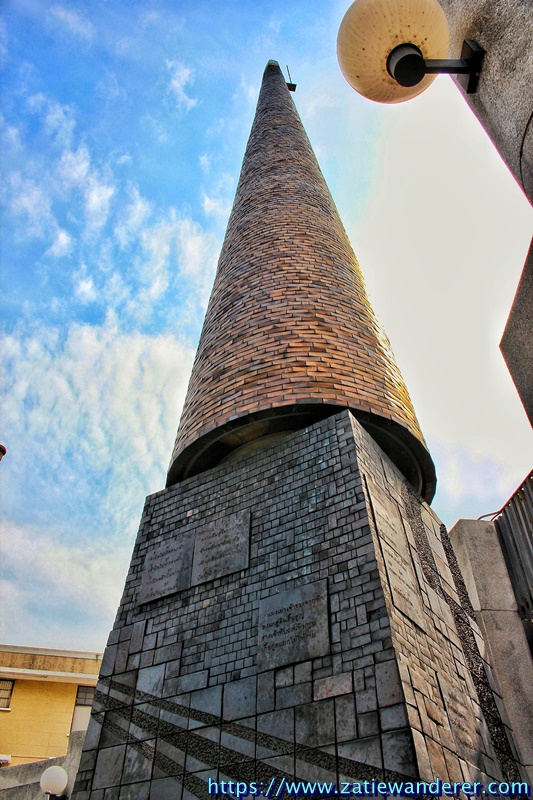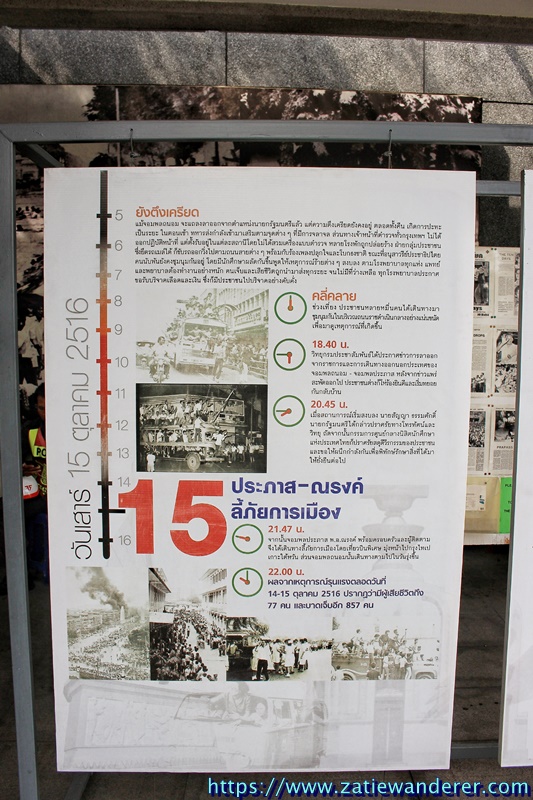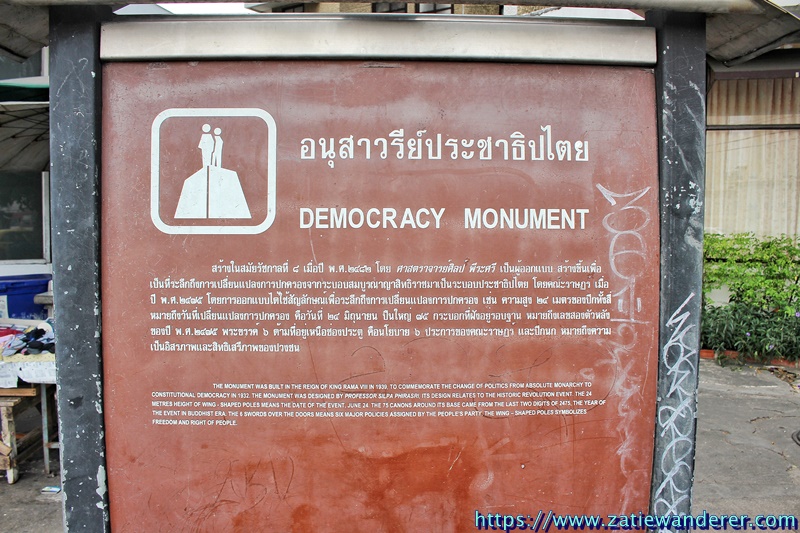Continued from Thailand – Laos: Day 9 – Part 1 – Aesah Rotdee Restaurant & Wat Bowonniwetwiharn Ratchaworawiharn. For pre-travel, please refer here.
Upon exiting Wat Bowonniwetwiharn Ratchaworawiharn, we continued on to a popular landmark which is the October Memorial. Everything I’ve bookmarked in Google Maps is within walking distance without having to take public transportation.

We headed to the east side of Khao San Road because there was a major road (or highway) between cities.

This is the back alley located behind the row of shops. I’m just taking pictures here and not going into this place.

As we set foot, we came across a family of backpackers who was walking across the street. Dad, mom, daughter … everyone carries backpacks, just like us! Sometimes, people like this have been backpackers quietly for a long time and don’t even make a fuss in FB groups. What matters is the goal achieved, not popularity.

His daughter stared at us from afar. Probably because I took pictures of them. We like you guys because we have the same interest in backpacks.
The rows of shops here are full of unique and creative items.

And I noticed a lot of shops sell silverware here. In this row alone, there are about 6-7 silver shops.

So, this is the place. For those who are interested in silver items, including jewelry and even ear piercings, you can come here.
We even bypassed the eastern part of Khao San Road. During the day, the road area is open for vehicles to enter and exit.

This is the main road or also known as a highway according to the version of the locals but not according to the Malaysian version. If I’m not mistaken, almost 5 lanes in all.

Every time we cross a big highway like this, we never miss taking a picture in the middle because of the landscape decoration.

The place we wanted to go was the October Memorial. When we almost arrived, we came across the traffic police on duty. Seems friendly then I immediately picked up Aqif to take a picture with them. He then posed with the most handsome police, hehe.

This is October Memorial. It’s a historic place that took place in 1973. It is also called:

- 14th October Memorial or
- 1973 Thai Uprising or
- Hetkan Sip-Si Tula or
- October 14 Event or
- Wan Maha Wippayok (Day of Great Sorrow)
Our journey from the Aesah Rotdee area to the 14th October Memorial. About 450 meters.
77 deaths and 857 civilians injured. That’s the number that happened on October 14, 1973. I’m not sure if this place was the beginning of the riots by the public or this place is one of the areas.

A monument built seemed like people hugging when a riot broke out between the public and the authorities.

Once inside, there is a booth guarded by the police. Even now, it is still taken care of from the beginning. Maybe they don’t want the incident to recur with the presence of activists who make this place a gathering area to start or spark riots.

There is no translation in English and I don’t know what these pictures have to do with it. Were they the ones who sparked the riots, were they national heroes or were they the victims who died during the incident?
This monument was built to commemorate this historic moment.

Because the tower was too high, I took pictures half at the top and half at the bottom. Both are important. Just look at the bottom there are notes and architecture that show a picture of a staircase leading up.

Still in Thai. I really don’t understand any of the information they are trying to convey here.

More information boards.

I’m lucky because here there are also newspaper clippings in English.

I think, these are the nameplates of those who were killed, which is a total of 77 people.

When entering this part of the photo, it seems that this place highlights the mistakes and wrongdoings that the authorities have done to the public in 1973.

More photos on display.

In fact, what happened was a protest started by some students against the arrest of 11 politicians made by the ruling Thai military junta at the time. The government is headed by dictator Thanom Kittikachorn who is deliberately changing the Thai political system.
Small-scale protest movements have been made by students since the 1950s. Only on October 6, 1973, 11 politicians were arrested for distributing leaflets to get the people to support the draft constitution that was being made. Since then, 2,000 students gathered and finally, 400 thousand people gathered to protest the government’s actions at that time. The rally was to force the government to release 11 detained politicians.
When 400 thousand people were ordered to disperse and the government promised to release, but only half. More than 200 thousand still gathered and set foot on the King’s palace. As a result of this action, all military assets were mobilized and vandalism also occurred. Eventually, riots between the authorities and the people ensued resulting in deaths and injuries.
Then, from the October Memorial, we set foot on the second popular landmark, the Democracy Monument. It feels like the construction of this monument has something to do with what happened to the October 14 tragedy. Meanwhile, I looked around the aisle that sold lottery numbers.

There are so many lottery shops and I took the opportunity to take pictures because such an atmosphere does not exist in Malaysia.

Haa … there’s more. If in Malaysia, this lottery is sold at a traffic light. While all the vehicles waited, the sellers shouted mahpiau, mahpiau, mahpiau.

Arrive at Democracy Monument. Just take pictures from a distance. At first, we intended to cross to go there but due to having a small child and having to cross a rather wide road, we canceled the intention. After all, there is nothing in the middle of it.

Although far in the middle of the roundabout, there was apparently an information board about the monument where we were standing. What does it say?

The monument was built during the reign of King Rama VIII in 1939, to commemorate the first change of political system from full monarchy to constitutional democracy in 1932. The monument was designed by Professor Silpa Phirasri, its architecture related to the historical events of the revolution. A 24-meter-high pole with a wing shape means the date of June 24th. While 75 cannons are inspired from the last 2 digits of 2475 which represent the year of the event referring to the year of the Buddhist era. The six swords at the gate mean the 6 main policies that have been implemented by the people’s party. The wing-shaped pillars represent the rights and freedoms of the people.
Our journey from the 14th October Memorial to the Democracy Monument was 350 meters.
Here is a department of Tourism Thailand. But because of all the information at our fingertips, we didn’t stop and kept stepping elsewhere.

It’s time to cross the road, heading somewhere.

The woman looked to the right, and I also looked to the right even though there were traffic police there. Look at the line over the road. I was a bit confused with it even I had a driver’s license since 1994.


While waiting for the traffic police for a signal to cross, I managed to look at Google Maps and there were two more historic Wats nearby. We set our foot to Wat Ratchanatdaram Woravihara.





Leave a Reply